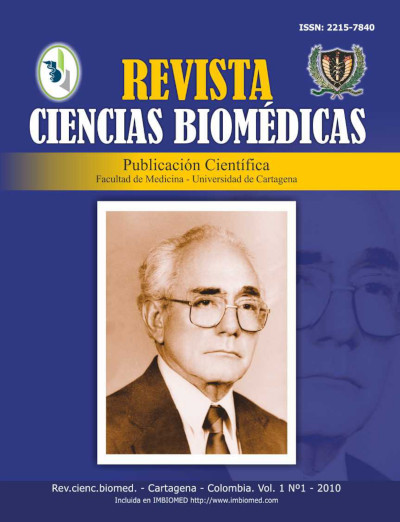Hemorragia intracerebral espontanea: apreciaciones básicas
Hemorragia intracerebral espontanea: apreciaciones básicas
Contenido principal del artículo
Resumen
La hemorragia intracerebral espontánea o no traumática corresponde a la extravasación de sangre al parénquima cerebral por ruptura de una arteria cerebral como consecuencia de la elevación de la presión arterial, de alteraciones en la coagulación sanguínea, de malformaciones arteriovenosas, entre otras. Sin embargo el epicentro del sangrado será siempre el parénquima cerebral, lo que lo diferencia de la hemorragia intraventricular primaria o de la misma hemorragia subaracnoidea. Se presenta una revisión practica para el médico general. Rev.cienc.biomed. 2010, 1(1): 59-63.
Palabras clave
Descargas
Datos de publicación
Perfil evaluadores/as N/D
Declaraciones de autoría
- Sociedad académica
- Universidad de Cartagena
- Editorial
- Universidad de Cartagena
Detalles del artículo
Referencias (VER)
Qureshi A, Tuhrim S, Broderick J, Batjer HH, Hondo H, Hanley DF. Spontaneous intracerebral hemorrhage. N Engl J Med. 2001; 344: 1450-1460.
Ariesen M, Claus S, Rinkel G, Algra A. Risk factors for intracerebral hemorrhage in the general population: a systematic review. Stroke. 2003; 34: 2060-2065.
Scherle Matamoros C, Pérez Nellar J, Dr. Roselló Silva H. Hemorragia intracerebral espontánea. Rev Cubana Med 2007; 46 4
Broderick J, Brott T, Tomsick T, Miller R, Huster G. Intracerebral hemorrhage is more than twice as common as subarachnoid hemorrhage. J Neurosurg. 1993; 78: 188–191
Anderson CS, Chakera TM, Stewart-Wynne EG, Jamrozik KD. Spectrum of primary intracerebral haemorrhage in Perth, Western Australia, 1989–90: incidence and outcome. J Neurol Neurosurg
Psychiatry. 1994; 57:936–940.
Counsell C, Boonyakarnkul S, Dennis M, Sandercock P, Bamford J, Burn J, Warlow C. Primary intracerebral haemorrhage in the Oxfordshire community stroke project, 2: prognosis. Cerebrovasc Dis. 1995; 5: 26–34.
Challa V, Moody DM, Bell MA. The Charcot-Bouchard aneurysm controversy: impact of a new histologic technique. J Neuropathol Exp Neurol. 1992; 51: 264–271.
Okazaki H, Whisnant J. Clinical pathology of hypertensive intracerebral hemorrhage. In: Mizukami M, Kogure K, Kanaya H, Yamori Y, eds. Hypertensive Intracerebral Hemorrhage. New
York, NY: Raven Press Publishers; 1983: 177–180.
Wakai S, Kumakura N, Nagai M. Lobar intracerebral hemorrhage: a clinical, radiographic, and pathological study of 29 consecutive operated cases with negative angiography. J Neurosurg. 1992; 76: 231–238.
Gorelick PB, Hier DB, Caplan LR, Langenberg P. Headache in acute cerebrovascular disease. Neurology. 1986; 36: 1445–1450.
Helweg-Larsen S, Sommer W, Strange P, Lester J, Boysen G. Prognosis for patients treated conservatively for spontaneous intracerebral hematomas. Stroke. 1984; 15: 1045–1048.
Broderick JP, Adams Jr HP, Barsan W, et al. Guidelines for the management of spontaneous intracerebral hemorrhage. A statement for healthcare professionals from a special writing
group of the stroke council, American Heart Association. Stroke 1999; 30: 905-915.
Brott T, Thalinger K, Hertzberg V. Hypertension as a risk factor for spontaneous intracerebral hemorrhage. Stroke 1986; 17: 1078-1083.
Castillo J, Dávalos A, Álvarez-Sabín J, Rubio F, Secades J, Lozano R. Estudio piloto aleatorizado y controlado por placebo de la eficacia y seguridad de citicolina en el tratamiento, en fase
aguda, de la hemorragia intracerebral primaria. Neurología 2003; 18: 533.481-555
Counsell C, Boonyakarnkul S, Dennis M, et al. Primary intracerebral haemorrhage in the Oxfordshire community stroke project. Cerebrovasc Dis 1995; 5: 26-34.
Anderson CS, Chakera TMH, Stewart-Wynne EG, Jamrozik KD. Spectrum of primary intracerebral haemorrhage in Perth, Western Australia, 1989-90: incidence and outcome. J Neurol Neurosurg Psychiatry 1994; 57: 936-940.
Leira R, Dávalos A, Silva Y, et al. Early neurologic deterioration in intracerebral hemorrhage. Predictors and associated factors. Neurology 2004; 63: 461-467.
Hoff JT, Xi G. Brain edema from intracerebral hemorrhage. Acta Neurochir Suppl 2003; 86: 11-15.
Rosand J. Hipertension and the brain. Stroke is just the tip of the iceberg. Neurology 2004; 63: 6-7.



 PDF
PDF
 FLIP
FLIP





